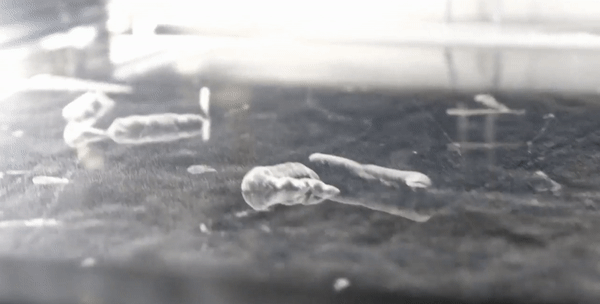Exhibits
Cloud Chamber
Particles are all around us. They are constantly buzzing by us, interacting with our eyes and senses, and even passing completely through us! Given their size, we cannot directly see these particles with our eyes, but we can use technologies to help us see their effects and measure them.
This cloud chamber exhibit is designed to show the constant bombardment of particles around us at any given moment. When a particle is travelling, it can interact with its surroundings, like bumping into other particles in the air. A cloud chamber is designed to show the path of particles as they fly through the air and interact with the gas inside the chamber. Cloud chambers were one of the earliest particle detectors developed and the development of them even won Charles Thomson Rees Wilson the Physics Nobel Prize in 1927!
The box is filled with a gas, usually isopropyl alcohol (rubbing alcohol) that has been evaporated, and is being cooled to very low temperatures. This creates a supersaturated environment inside the chamber. The alcohol exists in a vaporous state: it is gaseous, but is held at a temperature where it usually condenses into a liquid. If anything comes along and bumps the vapour molecules, disturbing their delicate equilibrium state, the molecules will rapidly condense into their liquid form in that region. When a charged particle travels through this vapour, it causes the vapour to ionize and will make those molecules electrically charged. Small droplets of vapour are then attracted to these charged regions and condense into liquid form, causing a trail that can be seen as white lines. The travelling particle itself is not being seen, but rather the path it took and its consequent reaction interacting with the vapour is what is being observed.

What are the causes of the different lines? Why are some thin and straight, while others are thick or wavy?
The bright thick line is caused by the largest interacting particle by size: it is the interaction of what is called an alpha particle. An alpha particle is a high energy composite particle consisting of two protons and two neutrons together: it’s the nucleus of a helium atom. Given that it is a collection of particles, it is larger than a single small particle, and that is why this line appears bigger and thicker than the other lines seen.
The second type of line is faint, thin, and can curve and bend as it travels through the chamber. This is caused by a particle called a beta particle. A beta particle can be a high speed electron, or its antiparticle, a high speed positron. You can read more about particles and antiparticles HERE ** link to other theory board beside cloud chamber **. These particles are small and that means the lines we see are fainter than the alpha particles. They also are much easier to have their direction changed due to their small mass, and this is why the bending of their paths occur.
The final type of line highlighted are those faint, but long streaks that travel in straight lines. These lines are created by particles known as muons. A muon is a fundamental particle that is similar to an electron, but much more massive – about 200 times more massive. The higher mass means that muons bump into the molecules in the cloud chamber but just bludgeon their way through, creating straight tracks. Muons can be created high in the atmosphere as cosmic rays travel through outer space. These rays contain alpha particles and protons, which when they collide with molecules in the atmosphere, can undergo nuclear decay and result in the formation of muons. Interestingly, the life span of muons is incredibly short – only about 2 microseconds! – and so the reason why these particles are able to exist long enough to travel through the atmosphere and long distance down to our detectors is because of relativistic effects. They are travelling fast enough to slow down their internal time, sufficiently long enough that they can reach the detectors and cloud chambers here on Earth’s surface!
